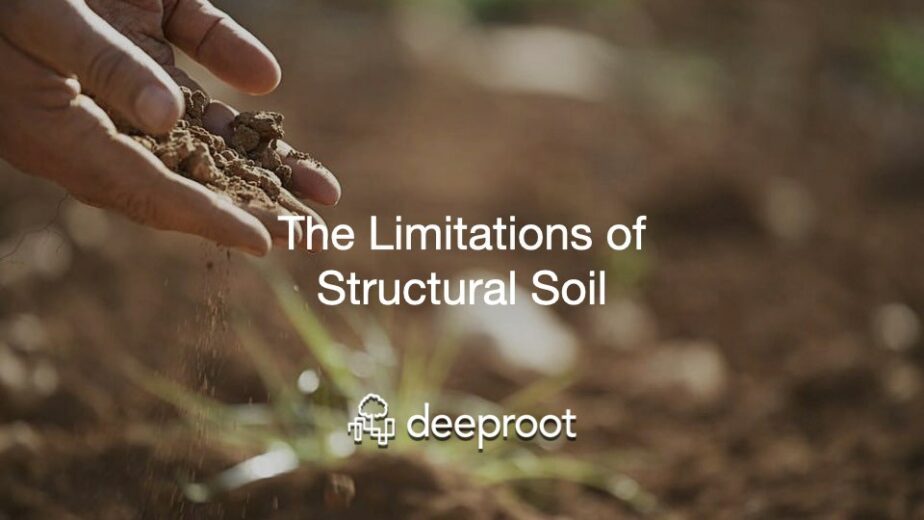It’s not unusual to find a piece of art or jewelry over 500 years old in a museum’s collection. These precious artifacts are (rightly) treated with great care commensurate with their value. Yet an inch of topsoil, which may have taken more than 500 years to develop, is commonly abused, mismanaged or discarded in the course of human activity. As you may have read before on this blog, urban soil is not necessarily “bad.” A soil expert should analyze a particular soil before making any recommendations, but urban soil is worth re-using more often than we might think.
Another recent post addressed the stockpiling and re-use of existing soil on a development site. While removal and re-use is a sustainable practice, also consider conserving soil in place, preventing soil disturbance wherever possible.
Why Keep Soil Undisturbed?
For effective tree preservation, soil is typically protected within tree protection zones (TPZs). Generally, the TPZ radius is 1 foot for every inch of trunk diameter, although this can vary. However, soil may also be protected in areas that will be landscaped, even if no trees are present. The main advantages of conserving soil in situ are as follows:
- Soil aggregates and permeability are preserved for better water infiltration.
- Soil microorganisms can continue their nutrient-cycling activities, reducing the need for additional amendments and fertilizers.
- Soil is less susceptible to erosion from wind or water.
When it comes to protecting soil, arborists and soil experts are in agreement. Techniques that prevent compaction and disturbance are good for both tree roots and the soil environment. Two common methods are protective fencing and surface buffers.
Protective Fencing

Protective fencing should be sturdy enough to prevent people from easily entering an area and using exposed soil for parking, storage or staging. Install the fencing at the beginning of the project and maintain it until completion, inspecting regularly for compliance. The City of Palo Alto, California’s Tree Technical Manual provides excellent fencing specifications: “[Install] five- or six-foot high chain link fences. Fences are to be mounted on two-inch diameter galvanized iron posts, driven into the ground to a depth of at least 2 feet at no more than 10-foot spacing.”
Surface Buffers

If an area cannot be fenced because it must be accessible to equipment, vehicles and materials, a surface buffer, sometimes known as a root buffer, will protect the soil from compaction. The Tree Technical Manual specifies: “The protective buffer shall consist of a base course of tree chips spread over the root area to a minimum of 6-inch depth, layered by 3/4-inch quarry gravel to stabilize 3/4-inch plywood on top.” Again, the buffer must remain in place for the duration of the project, unless the area can later be fenced.
Warning! Soil is particularly vulnerable to compaction during the installation and removal of the buffer itself. Without careful planning and supervision, wheeled equipment may drive repeatedly on exposed soil transporting wood chips, gravel and plywood, defeating the purpose of the buffer. The solutions vary depending on the site. Operate equipment from adjacent pavement if possible, or install an initial area of the buffer by hand until the equipment wheels can be on the buffer at all times. Remove the buffer “backwards” so equipment remains on what is left of the buffer while working.
Other Soil Conservation Techniques
Other general methods for soil conservation are noted in the new ISA publication Best Management Practices: Soil Management for Urban Trees:
- If needed, modify protective fencing to serve as a windbreak to minimize erosion.
- If the site is irrigated, continue irrigating to maintain the health of existing trees and soil microbes. Where possible, slow water flow to retain water and topsoil on site.
- Keep existing plants where possible – even weeds – until the landscaping phase to retain soil water and control erosion.
- Remove and dispose of construction debris offsite to prevent soil contamination and changes in pH.
- For new landscaping, choose tree and plant species that will thrive in existing soil conditions to minimize the need to modify the soil.
- Apply amendments and nutrients only as needed to address deficiencies discovered in the initial soil analysis. Top-dress rather than till in amendments.
- Choose the smallest plant size possible, even using seeds where appropriate.
Conclusion
Soil is a valuable natural resource that is easily destroyed and not so easily renewed. Consulting a soil expert early in the development process allows for more effective soil preservation. Borrowed techniques for protecting tree root zones will also protect the soil itself.
Ellyn Shea is an arborist and consultant in San Francisco.
All images courtesy of the author.







Leave Your Comment